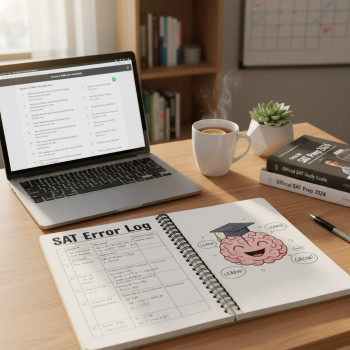Why tracking productivity matters more than blind hours
Studying for the Digital SAT isn’t about grinding non-stop; it’s about focused, measurable progress. You can log twenty hours a week and see no improvement, or you can log ten high-quality hours that push your score up by 50 points. The difference is tracking. When you measure what you do—what you get right, where time leaks, and how your mental energy shifts—you can make small, smart changes that compound into big score gains.
Think of tracking as a personal coach in spreadsheet form. It tells you when you’re improving, when you’re plateauing, and where to pivot. It turns vague effort into clear feedback. And feedback is how learning accelerates.
Which productivity metrics actually matter for SAT study
Not all metrics are equal. Some data is noise; some is signal. Below are the metrics that provide clear, actionable information about your study effectiveness.
1. Focused study time (quality minutes)
Quality beats quantity. Instead of total time, track productive minutes spent on focused study—no phone, no multitasking, real engagement with the question or concept. Use a simple Pomodoro log: 25–45 minutes of focused work followed by a short break. Count only the focused minutes.
2. Correctness by question type
Track accuracy for question categories: command of evidence, sentence correction, algebra, functions, problem solving with data, grid-in math, multi-step reasoning, and so on. This helps you see strengths and weak spots at the micro level.
3. Time per question (and variance)
The Digital SAT is adaptive and timed differently than older formats, so pacing is crucial. Record average time spent on each question type and note the variance. Large variance often signals guessing or rushing under stress.
4. Practice-test score progress
Full-length practice tests remain the best high-level metric. Track composite scores and subsection scores over time, and pair the numeric trend with notes: fatigue, distractions, or testing environment differences.
5. Review depth (error-analysis minutes)
How much of your study time is spent reviewing mistakes? Time spent on focused review—diagnosing why an answer was wrong and creating a plan to fix it—is a multiplier for learning. Track minutes spent on review and tag each error with a root cause (concept gap, careless error, timing, misread question).
6. Consistency (days studied per week)
Regular, short sessions beat occasional marathons. Measure how many days you study each week and how many sessions per day. Consistency is a strong predictor of retention.
7. Confidence vs. accuracy
After each practice question or set, rate your confidence (low/medium/high). Track when confidence mismatches accuracy. High confidence + wrong answer = a dangerous blind spot to correct quickly.
Tools you can use (simple and smart)
You don’t need fancy software to track these metrics. Start with simple tools and add analytics as you go.
- Spreadsheet (Google Sheets or Excel): Your most flexible tool—use it to log date, time, study type, focused minutes, practice-test scores, question types missed, and notes.
- Pomodoro apps: Forest, Focus Keeper, or just a timer—help track focused minutes.
- Practice platforms: Use official digital practice tests and a digital notebook to export scores and timestamp practice tests.
- Notes app or physical notebook: For error-analysis tagging and confidence ratings.
- Optional: A habit tracker (streaks) to visualize consistency.
How to set up a simple SAT productivity dashboard (step-by-step)
Here’s a clean, student-friendly dashboard you can build in a spreadsheet in under an hour. It’ll give you the high-signal metrics you need without overcomplicating things.
Step 1: Create a weekly log sheet
Columns: Date, Session Start, Session End, Focus Minutes, Study Type (Practice Test / Targeted Practice / Review), Material (e.g., Algebra: Linear equations), Distractions (yes/no with notes), Confidence Level.
Step 2: Create an error-analysis sheet
Columns: Date, Test/Block, Question #, Correct/Incorrect, Question Type, Root Cause (Concept / Careless / Time / Reading), Fix Plan (what to study next), Follow-up Date.
Step 3: Add a weekly summary view
Use formulas to calculate: total focused minutes, average minutes per session, days studied, practice-test averages, accuracy per question type, and number of errors by root cause.
Step 4: Visualize trends
Make 2–3 charts: (1) Practice-test score trend over time, (2) Accuracy by question type bar chart, (3) Focus minutes vs. score scatter. Visual cues make decisions easier: if focused minutes increase but scores stay flat, the problem might be review quality or mistaken study methods.
What a weekly routine looks like with tracking
Below is a realistic weekly routine for a student balancing school, activities, and SAT prep. All times are examples—adapt them to your life.
- Monday: 45-minute targeted practice (Reading: passage strategy). Log focused minutes and confidence. Spend 20 minutes reviewing errors and tagging root causes.
- Tuesday: 25-minute math concept drill (algebra fundamentals). Quick error review and schedule a follow-up for any concept gaps.
- Wednesday: Full 50-minute practice block simulating test section pacing. Log time per question and review mistakes in depth (30 minutes).
- Thursday: Light review + vocabulary/grammar drill (30 minutes). Focus on suspicious high-confidence mistakes.
- Friday: Mock section or adaptive practice; note timing patterns and energy levels.
- Saturday: Full-length practice test every 2–3 weeks. Otherwise, two shorter focused sessions (math and reading) with deep review.
- Sunday: Rest or light review of your week’s error log and plan next week’s focus.

Sample dashboard table: Weekly snapshot
| Metric | Week 1 | Week 2 | Week 3 | Target |
|---|---|---|---|---|
| Total focused minutes | 480 | 360 | 420 | 450 |
| Days studied | 6 | 5 | 6 | 6 |
| Average accuracy (targeted sets) | 72% | 75% | 78% | 85% |
| Practice test score (composite) | 1180 | 1210 | 1250 | 1350 |
| Top root cause of errors | Timing | Careless | Concept gap: functions | Careless & concept gaps minimized |
Interpreting your metrics: what to do with the data
Numbers are only useful when they guide action. Here are common patterns and what they should prompt you to change.
1. Focused minutes up, scores flat
If you’re spending more productive time but not improving, examine your review. Are you redoing the same problems without diagnosing root causes? Shift time from blind practice to deliberate review—explain wrong answers aloud, create mini-lessons for yourself, or teach a friend.
2. High accuracy but low practice-test score
This often means your small-set practice is too easy or not representative. Introduce mixed, timed sections to simulate the test. Also, track time per question: are you accurate but slow?
3. High confidence + low accuracy
Blind spots. Mark those items for immediate correction. Add a weekly session to target high-confidence mistakes and create a checklist for common pitfalls (e.g., misreading comparative passages, missing negative signs in algebra).
4. Timing variance is high
Work on pacing strategies: bracket questions (set a time limit per question, flag for return), practice under closer test conditions, and do targeted speed drills for specific question types that slow you down.
How to run effective error analysis
Error analysis is the engine of improvement. Many students skip it because it feels slower, but it’s where the most learning happens. Here’s a practical routine for every incorrect answer.
- Step 1: Re-solve without looking at the answer. If you still get it wrong, note the exact stumbling point.
- Step 2: Tag the root cause (concept, careless, time, misread).
- Step 3: Write a one-sentence summary of the correct approach you will use next time.
- Step 4: Schedule a follow-up practice item of the same type within 48–72 hours.
Measure how many errors per week convert to corrected mastery after follow-up. If you correct 70% of tagged issues, you’re building durable learning.
Examples: Three student profiles and their metric plans
Concrete examples help make abstract metrics real. Here are three typical students and how they should track and act on metrics.
Profile A: The Busy Achiever
Context: High school junior juggling AP classes and after-school activities. Has 6–8 hours weekly for SAT prep.
- Metrics to prioritize: Focused minutes per day, days studied, and practice-test schedule (every 2–3 weeks).
- Strategy: Short daily Pomodoros (25–35 minutes), two weekly focused review sessions, one full practice test every 2 weeks.
- Goal: Make weekly review count—convert at least 60% of tagged errors to mastery within a week.
Profile B: The Late-Start Senior
Context: Senior with 10 weeks until test day, moderate baseline knowledge but needs score boost quickly.
- Metrics to prioritize: Practice-test score trend, time-per-question, and error root causes.
- Strategy: Two full practice tests per week (timed), daily targeted drills, and daily 30–60 minute focused review sessions. Use intense error-analysis and immediate follow-up.
- Goal: Gain 40–80 points in 10 weeks by converting concept gaps to consistent correctness and improving pacing.
Profile C: The Confident but Careless Student
Context: Generally understands content, but frequent careless mistakes and misreads drag scores down.
- Metrics to prioritize: Careless error rate, confidence vs. accuracy mismatch, and review-depth minutes.
- Strategy: Add a pre-answer checklist (read question twice, underline key info), log confidence after each question, and schedule slow, deliberate review of careless errors.
- Goal: Reduce careless error rate by 50% in 6 weeks, which often yields a large score jump without heavy new content learning.
Using practice-test analytics wisely
Practice-test analytics are gold—but only if read correctly. Don’t obsess over single-test noise. Instead:
- Track trends across 3–5 tests. Look for consistent movement rather than one-off spikes.
- Pair scores with contextual notes (sleep, distractions, time of day) to explain outliers.
- Break down the test into blocks and examine performance per block. Is your reading accuracy worse in the later sections? That points to stamina issues.
How personalized tutoring (and AI-driven insights) can fit into tracking
Personalized tutoring is most powerful when it’s tied to good data. A tutor or program that reviews your dashboard can help translate numbers into action faster. For example, Sparkl’s personalized tutoring combines 1-on-1 guidance, tailored study plans, and AI-driven insights to identify the root causes behind your errors—so you spend less time guessing and more time fixing the right things.
When you feed your metrics to an attentive tutor, they can prioritize the 20% of topics that cause 80% of your errors, adjust pacing drills to your specific time-per-question profile, and help maintain accountability through weekly check-ins. If you’re feeling stuck or don’t know what to change next, a targeted session with an expert can cut through analysis paralysis and put you back on a data-backed path to improvement.
Common tracking pitfalls (and how to avoid them)
Tracking can get overwhelming if you try to measure everything. Here are common mistakes and quick fixes.
Pitfall: Tracking too many metrics
Fix: Start with 3 core metrics—focused minutes, practice-test score, and error root cause distribution. Add more only if they help make a decision.
Pitfall: Logging without acting
Fix: Pair every metric update with one decision: practice more, review differently, or change pacing. Data without decisions is busywork.
Pitfall: Blaming yourself for noise
Fix: Expect noise. Look for consistent patterns and treat anomalies as hypotheses to test, not personal failures.
Measuring psychological productivity: motivation, fatigue, and mindset
Not all productivity is numeric. Your mental state determines how effective each minute is. Track subjective metrics too:
- Motivation (scale 1–5 at session start)
- Fatigue level (1–5)
- Distraction triggers (what pulled you away?)
Correlate these with accuracy and focus minutes. You’ll see patterns—maybe your best work happens in the morning, or you need a break after school before tackling difficult math. Adjust your schedule to align high-cognitive tasks with your peak energy windows.
Celebrating progress and setting realistic milestones
Small wins matter. Rather than fixating on a large target score from day one, set intermediate milestones tied to the metrics: increase focused minutes to 450 per week, reduce careless errors by 30% in four weeks, raise section accuracy to 80%. Celebrate each milestone—this keeps motivation high and makes the long journey manageable.
Putting it all together: A 6-week metric-driven plan
Here’s a compact plan you can follow. It assumes roughly 6–10 hours per week of study, adjustable as needed.
- Week 1: Baseline. Take a full practice test under timed conditions. Build your spreadsheet dashboard and tag every error for root cause.
- Week 2: Fix high-frequency errors. Focus on the two most common root causes. Track focused minutes and confidence mismatch.
- Week 3: Pacing and strategy. Add timed mixed sections and speed drills. Measure time-per-question and variance.
- Week 4: Deep review. Re-test problematic concepts and verify improvement on targeted sets. Evaluate correction rate for tagged errors.
- Week 5: Simulation. Take another full practice test; compare trends across tests and adjust strategy. Introduce a longer test-day routine (sleep, food, breaks).
- Week 6: Polish and taper. Focus on stamina, final pacing adjustments, and restful, confident preparation before test day.
If at any point you feel stuck, consider a targeted 1-on-1 session with a tutor who can review your dashboard and recommend specific interventions. Personalized tutoring—like Sparkl’s tailored study plans and expert tutors—can accelerate the loop from data to action.
Final thoughts: Data + judgment = fast improvement
Tracking productivity metrics for SAT study is not about becoming a robot; it’s about giving your instincts better information. The numbers tell you where to push, where to pause, and where to change course. Combine clear metrics with good judgment—honest self-reflection, rest when you need it, and targeted practice when you don’t—and you’ll study smarter, not harder.
Start small: log one week, learn one insight, change one habit. In a month you’ll have meaningful trends; in two months, measurable score gains. And if you want help turning your spreadsheet into a plan that actually raises scores, a brief personalized tutoring session can map your metrics to a custom study roadmap so you’re always practicing what actually moves the needle.
Good luck—you’ve got a data-informed map now. Use it, iterate, and remember: steady, tracked effort wins tests.
















No Comments
Leave a comment Cancel